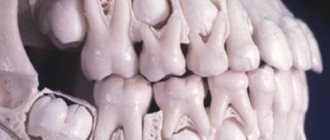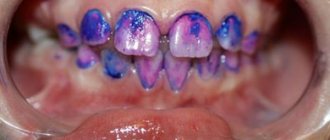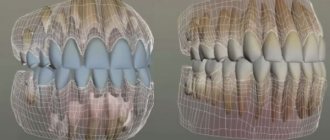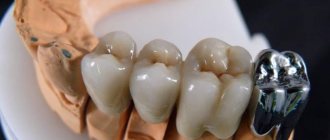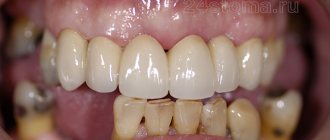What are crowns for baby teeth?
It happens that a baby tooth is severely damaged and cannot be restored with a filling. However, it is always worth trying to save the tooth and avoid extraction. In this case, we recommend placing a crown on the baby tooth. The crown is fixed with special cement, completely covers the entire visible part of the tooth and allows you to preserve its function.
The service life of the crown is until the physiological change of teeth; it falls out along with the milk tooth when it is replaced by the molar.
What are they for?
The negative consequences of early tooth loss can be different:
- in its place a free space forms and the neighbors begin to move in this direction, disrupting the correct bite;
- when a molar erupts, there may be no space left and it will grow crooked or in the wrong place, crowding may occur, requiring long-term orthodontic treatment, and some teeth become impacted (they do not erupt, but remain in the jawbone);
- Chewing function deteriorates, which means the functioning of the digestive tract is disrupted, the digestive organs begin to ache, poorly absorb nutrients, causing a deficiency of vitamins and minerals;
- lack of proper load on the jaws leads to disruption of their development;
- speech therapy problems arise, diction worsens;
- if there are not several units, then the density of jaw closure increases, which worsens the contours of the face.
Thus, incomplete dentition in childhood is more likely not an aesthetic, but a medical problem that requires a timely solution. Closing the coronal part with an artificial crown will help avoid troubles and subsequent expensive treatment.
The change from temporary to permanent teeth occurs in certain periods (in years):
- central incisors - no earlier than six;
- lateral incisors - from seven;
- fangs - from eleven;
- painters of fours, fives - from ten;
- seven from eleven.
If signs of caries appear before the specified period, then you need to urgently consult a dentist, since pathology develops rapidly in children.
How does the crown installation process work?
- Metal crowns. We place such crowns both during a regular outpatient appointment and during sleep treatment. First, the dentist treats the tooth that will receive a crown. The installation of the crowns itself can take place under local anesthesia or during sleep treatment. The height of the tooth is reduced using a special bur, then the doctor smoothes the corners and creates the necessary recesses and gaps. Then he selects crowns of the required size and shape for each of the teeth, tries them on and then cements the crown on the tooth.
- Metal-ceramic aesthetic crowns for the front teeth. We place such crowns only on young children during dental treatment during their sleep.
Types of crowns
For children's prosthetics, ready-made dentures of various shapes and sizes are made, corresponding to incisors, painters, and fangs. During installation, adjustments are made to the anatomical features.
Materials used:
- Metal ones, usually steel or an alloy of nickel and chromium, are used on painters, as they stand out strongly against the white background of their dentition. They are inexpensive, reliable, strong.
- Metal with a white composite lining can be installed in the smile area.
- Composite strip crowns practically do not stand out and look like natural ones.
If there is a high risk of developing caries, then when permanent teeth erupt, doctors recommend fissure sealing, that is, sealing the upper chewing part.
Prevention of dental prosthetics in children
Premature loss of baby teeth, and therefore dental prosthetics in children, can be avoided if you promptly and regularly visit a dentist who diagnoses the condition of the teeth, identifies possible bite defects and diseases of the oral cavity. Proper dental care and attendance at preventive examinations will eliminate the problem at the initial stage, avoid tooth loss and the need for prosthetics. The child’s nutrition also plays an important role in the preservation of baby teeth. After all, if there is a lack of substances necessary for a growing body, teeth are destroyed on their own, without mechanical impact on them. Currently, with busy parents and unfavorable environmental and economic factors, the condition of children’s teeth is worsening every day and prosthetics of baby teeth is becoming increasingly important. Therefore, preventive measures should be taken to maintain dental health from an early age.
Why do children still need to restore their teeth?
Firstly, restoration of baby teeth makes it possible to preserve these teeth until their natural replacement, and, therefore, guarantees the normal eruption of permanent teeth.
Secondly, restoration of baby teeth protects the child from developing health problems caused by the inability to bite and chew food normally. In addition, milk teeth that have the correct shape are an indispensable condition for the baby to develop correct and clear diction.
Thirdly, restoration of baby teeth relieves the child of psychological problems associated with the absence of frontal teeth.
What is it and what does it look like
Strip crowns are a system for restoring damaged front baby teeth in a small child. They look like the thinnest transparent acrylic caps, which help you create a new crown in just half an hour or less. The strip system comes with a set of 16 acrylic coping options for your dentist to choose from. All other tools and materials can be found in any dental clinic - grinding burs and grinding attachments, probes, filling materials, blue light lamps, bonds, antiseptics.
It is interesting that although strip crowns help restore teeth, they are difficult to classify as prostheses. After all, after restoration, the Strip Crown is removed from the restored tooth, and the real prosthesis remains on it.
What did you do in your dream
Pull out a tooth (pull out)
in a dream - cut off all ties yourself, but if a tooth falls out without your participation, it will not depend on you; vomit without blood - the injured person is not your blood relative. Pulling out blood indicates the need for separation from the bloodline. To remove a rotten tooth (extraction, pull out) - perhaps this will be a painful procedure for you, but you will have to remove a loved one from your society who brings nothing but trouble into your life. Moreover, if you saw in a dream that you removed it yourself, then you will have to complete this unpleasant mission yourself, without resorting to anyone’s help. If you are torn out, the rejection will happen thanks to someone. To remove a tooth from your mouth using a tool, you will have to thoroughly prepare for the unpleasant procedure of breaking ties. Not just remove, but tear up - destruction will inadvertently fall on those who, one way or another, are related to this matter/person.
Spit out
teeth in a dream (spitting out) - rejection of what was lost. Even if you have experienced pain from losses, you will abstract yourself from what is happening in order to drown out the suffering.
“What does tooth loss without blood mean according to the dream book? The front lower ones fell out. There was no pain. He just took it and spat it out. I’m standing there, surprised.”
Representatives of the fair sex with whom you communicate closely (who are not your bloodmates), to your surprise, will leave you painlessly. Soon you will forget about what happened.
Dreaming about loss
teeth (to lose, to lose) are major upsets, often associated specifically with the loss of dear people.
If in a dream you lose teeth that have already fallen out and were with you, it means parting with the memory of the past. On the contrary, if you find
something, something will happen that will make you remember former connections, plans, tragedies. This is not necessary now, so try not to dwell too much on the past days, look to the future.
Treat in the dream book
teeth at the dentist means - for the patient - to get better thanks to good care, proper treatment and professionalism of doctors;
Having survived stress, improve your situation. To treat yourself in a dream - the interpretation says that you are trying to rectify the situation, but a positive final result is now difficult to guarantee. Drilling
means a state where you are forced to endure something very unpleasant, but understanding the importance gives strength.
Often such dreams come to people caring for their sick family members. To seal
- the interpretation of the dream will be hiding an unsightly secret from everyone.
Inserting
teeth in a dream means trying to replace those close to you who are missing with a weak semblance of them.
Just watching
- being meticulously interested in the personal affairs and problems of the people you consider dearest to you.
Break
- cause irreparable harm to yourself and those closest to you.
According to the dream book , clean
teeth in a dream - worry about your reputation (your own or your social circle).
Brushing with a toothbrush - your actions will be balanced and reasonable. To clean with someone else’s brush is to try to whitewash yourself at someone else’s expense. This will not work. You still risk getting your hands dirty. To whiten
is to become so preoccupied with one’s own image that one’s efforts become excessive. Too good is not good either. Don't overdo it.
Prices for dental prosthetics for children
The cost of prosthetics for primary teeth depends on the category of the clinic, the qualifications of the specialist, the amount of work of the dental technician and the material from which the prosthesis will be made. Moreover, the initial consultation with a pediatric dentist in most clinics is free.
| Type of prosthesis | Price |
| Removable denture made of acrylic | from 12,000 rubles |
| Bridge prosthesis | from 25,000 rubles |
| Clasp denture | from 30,000 rubles |
| Quadrotti removable denture without palate | about 32,000 rubles |
Dentures for teeth
| Type of prosthesis | Material | Characteristics |
| Crowns | Stainless steel, metal alloys, acrylic (Strip crowns) Metal alloys | They are used for partial dental caries damage, trauma, and bruxism. The procedure for installing such prostheses is much faster and easier than conventional filling. In this case, the pulp is preserved, and the tooth is ground according to the method for “adult” prosthetics. During the installation of the crown, the doctor must carefully ensure that the crown does not extend beyond the edge of the gum. Fixed crowns can be placed on children aged 1 to 12 years, as they do not interfere with the natural process of baby teeth falling out. |
| Pins | Metal alloys | The design of the pin for children's dental prosthetics is similar to the design of the pin for adults. The children's pin differs only in a special element for more reliable fixation. As a rule, pins are installed in the roots of the front teeth in the upper jaw and canines in the lower jaw. According to the generally accepted method, the preparation of the supragingival part of the root for subsequent prosthetic restoration with a pin is carried out with carborundum stones. |
| Tabs | Metal alloys | Microprostheses, which are installed in place of missing tissues and recreate the anatomical shape of the tooth. In prosthetics, baby teeth are used to eliminate defects with the obligatory preservation of the dental pulp. |
| Bridges | Stainless steel, metal alloys | A structure consisting of several crowns that is attached to natural teeth. Restores chewing function and preserves the aesthetics of the smile. |
| Immediate dentures | Acrylic, nylon | The most popular type of partial dentures. Used to replace one lost tooth. Almost invisible. It takes some getting used to. It is characterized by the absence of contraindications and is suitable for all patients without exception. |
| Clasp dentures | Nylon | Comfortable, ensure even distribution of load between all teeth. They exactly follow the contours of the gums and are therefore quite complex to manufacture and require several visits to the dentist. Elastic and flexible, they are fixed to adjacent teeth with soft nylon clasps. It takes some getting used to. They do not rub the gums and are almost invisible due to their transparency. |
| Complete overdentures | Acrylic, nylon | Completely replace all teeth on one or both jaws. They are attached to the palate by suction or using a special cream. They are durable and do not require special care. |
Features of dental prosthetics in children
Children's dental prosthetics has its own nuances. Firstly, in adults the jaw is formed, while the child is growing all the time, and the dentist must do everything possible to ensure that the prosthetics of baby teeth does not disrupt the development processes in the body. Therefore, dentures for children must be hypoallergenic, safe, comfortable, and resistant to chemicals. Therefore, for the manufacture of children's dentures, materials such as acrylic, chrome-plated steel, stainless steel, silver and tin alloys are used. Secondly, children's structures should not interfere with jaw development.
According to their purpose, dentures for children are divided into the following groups:
- therapeutic – restore functions and correct the structure of teeth;
- preventive – prevent deformations and pathologies in the development of teeth and jaws;
- fixing – used for fastening orthodontic appliances and therapeutic materials.
Interesting fact!
Hippocrates called children's teeth milk teeth. He was convinced that the first set of human teeth developed from the milk that infants fed.
How to choose a clinic for prosthetics of baby teeth?
When choosing a clinic for prosthetics of baby teeth, it is necessary to study information about the institutions performing this procedure, and, in particular, find out whether they have licenses to provide dental services to children. There are few such clinics, but you should still be puzzled by finding exactly the dentistry where your child will be provided with professional assistance in prosthetics of baby teeth by specialists with appropriate qualifications.
How to care for children's dentures?
Children should care for dentures in the same way as natural teeth. You should brush your teeth twice a day and after every meal. If there are no necessary conditions for this, rinsing with clean water and using dental floss is acceptable. In some cases, depending on the material of the dentures, it is necessary to carry out regular professional cleaning of the dentures in the dental office.
Who produces Strip crowns
The leading manufacturer of Pediatric Strip Crown Forms (as the products are officially called) is the American corporation 3M, a division of ESPE. In addition, it produces innovative and popular consumables for dentistry. It was 3M ESPE that developed the world's first natural-colored material for tooth restoration, the first universal cement with self-adhesive1 ability, and the first nanoionomer material (for ideal restorations of anterior teeth).
The 3M company is known for its medical respirators, UNITEK brace systems, consumables for surgery, dressings, sterilization devices, stethoscopes, industrial and transport equipment. The list can be continued for a very long time. But the most famous “work” of the 3M concern in the world is adhesive tape, known as “scotch tape”.
Complex on 4 OSSTEM implants with delayed loading - 150,000 rubles.
Complex implantation Osstem (South Korea) with delayed loading after 4-6 months.
Doctor's work guarantee - up to 5 years (under an agreement on the provision of medical services) Call now or order a call
Opening hours: 24 hours a day - seven days a week


